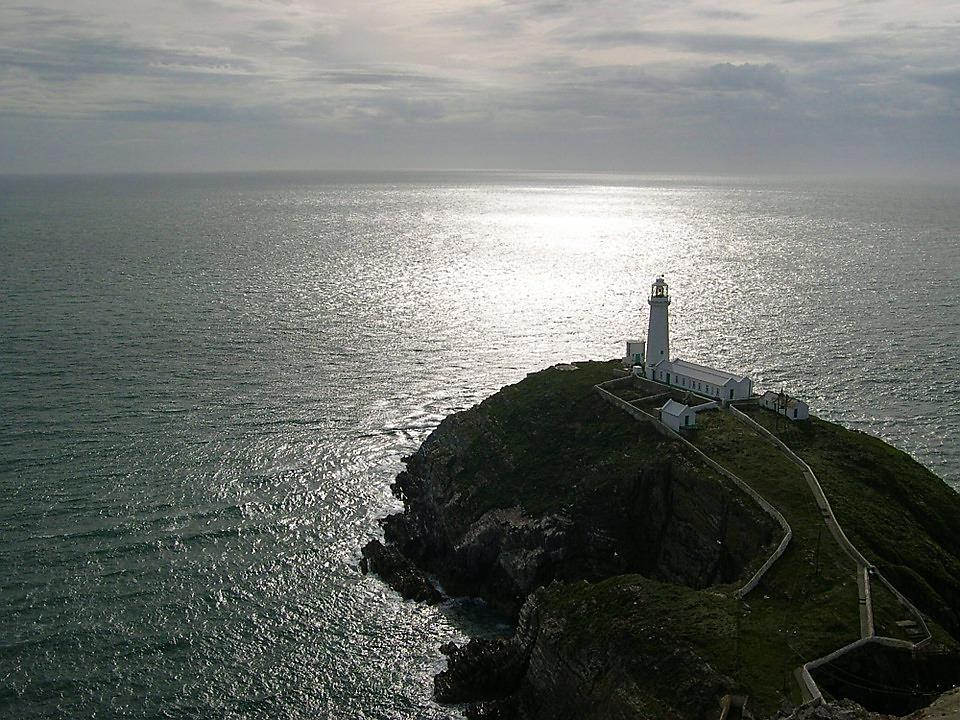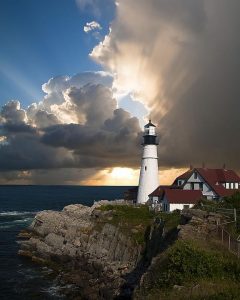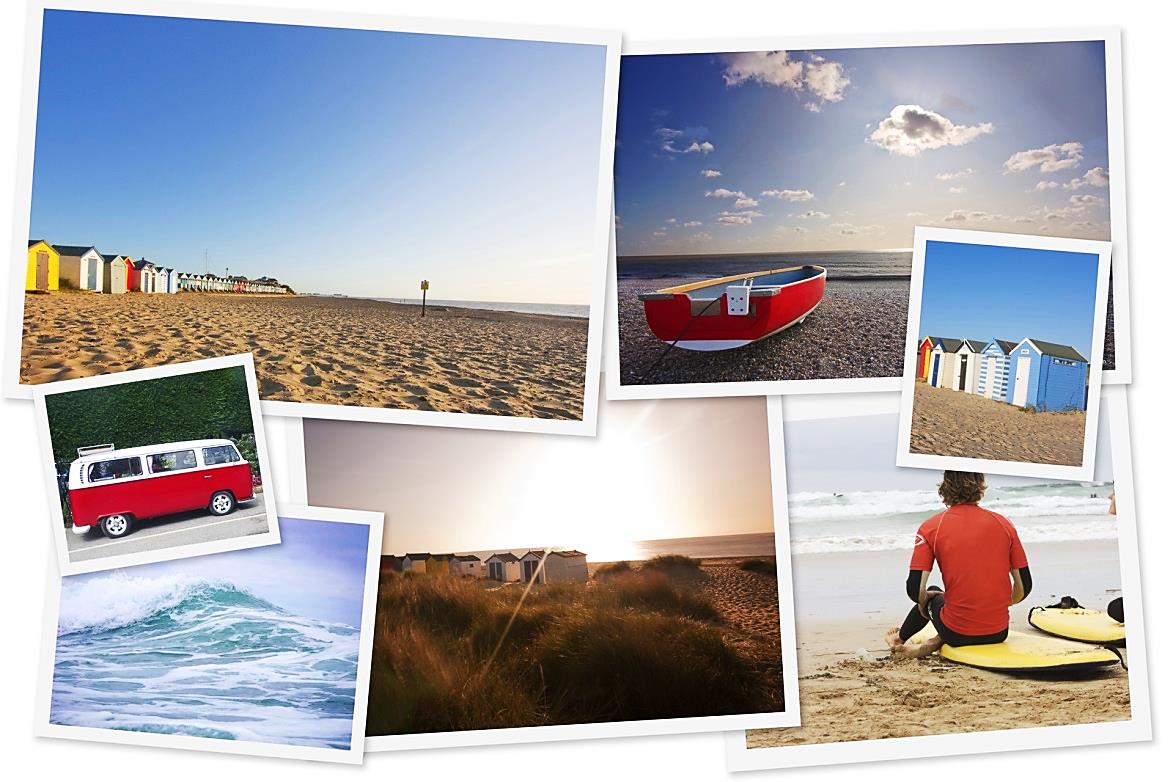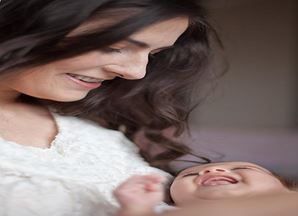
by Fern Shaw | Jul 20, 2016 | Uncategorized
Lighthouses have long held a fascination for many people, me included. Perhaps it’s to do with the analogy between the wild seas and the shining beacon and staidness that a lighthouse offers; the fact that many lighthouses may have started out in the era of exploration as nothing more than a pile of wood built on the highest point of a promontory, but due to their importance, they were then built to withstand centuries of wild seas and inclement weather or because they signify safety in a wild, watery world.
It could also be because that there’s a dichotomy between the illusion of safety of a lighthouse and those terrible dark days when smugglers and the like used to light false beacons to lure trade ships onto rocky shores so they could pilfer the contents.
Whichever it is, the allure of the lighthouse continues. A few favourites are:
 Fastnet Rock Lighthouse, Ireland. The elegant and beautifully waisted tower structure was designed by William Douglass, an engineer with Irish Lights, and was built from coarse-grained Cornish granite apparently came from the Cheeseswring quarry on Bodmin Moor. Over 2,000 blocks were cut and shaped to interlock one into another.
Fastnet Rock Lighthouse, Ireland. The elegant and beautifully waisted tower structure was designed by William Douglass, an engineer with Irish Lights, and was built from coarse-grained Cornish granite apparently came from the Cheeseswring quarry on Bodmin Moor. Over 2,000 blocks were cut and shaped to interlock one into another.
Whiteford Lighthouse, South Wales is the only cast-iron lighthouse in Britain which is wave-washed, although it can be reached on foot at low tide.
Bell Rock Lighthouse, Scotland – The world’s oldest surviving sea-washed lighthouse was built on the Bell Rock, 11 miles from the shoreline. First lit in 1811, it stands 35 metres tall and its light is visible from 35 statute miles inland. The challenges faced in the building of the lighthouse have led to it being described as one of the Seven Wonders of the Industrial World.
The Eddystone Lighthouse, England is on the dangerous Eddystone Rocks, 9 statute miles south of Rame Head. The current structure is the fourth to be built on the site. The first and second were destroyed by storm and fire. The third, also known as Smeaton’s Tower, is the best known because of its influence on lighthouse design and its importance in the development of concrete for building.
Lighthouses seem to inspire thousands, if not millions of people – you’ll find more analogies than you can shake a stick at. For the poets among us, I find this quote particularly wonderful:
“What does a lighthouse do? I ask myself. It never moves. It cannot hike up its rocky skirt and dash into the ocean to rescue the foundering ship. It cannot calm the waters or clear the shoals. It can only cast light into the darkness. It can only point the way. Yet, through one lighthouse, you guide many ships. Show this old lighthouse the way.” – Lisa Wingate, The Prayer Box.

by Fern Shaw | Jul 15, 2016 | Uncategorized
Summer is upon us – lift your hands in air and say – Hey ayyy! But what to do and where to go inside of our now less than frosty shores? Here are a few suggestions that may shine some light on your wintery grey matter:
Woodland Trust – The UK has centuries-old oaks, beeches and cedars – and the Woodland Trust is keen to protect our ancient trees. Help the trust by setting out to explore Britain’s oldest forests. Give a tree a hug to see how far your arms stretch round – they become important when the girth of the trunk is one to four arm spans.
Real Ale Trail – Create your own real ale trail by train for just a few bob. A hop-on, hop-off day return on the St Ives Bay Line in Cornwall will take you past real ale pubs in Lelant Saltings, St Erth, Penzance and St Ives. That’ll certainly put the hop in your journey!
Visit Flat Holm Island – Sail across the water to Flat Holm Island in the Bristol Channel and spend the day wildlife spotting. There are boat trips that can be arranged to the island to visit for the day or for longer stays.
Rooftop Films – Watch a movie al fresco during the Rooftop Film Club season, which runs until September 30, with screenings in Camden, Peckham, and Shoreditch. They’ll also take place at Somerset House and in Trafalgar Square.
Banksy art – Go in search of works by elusive graffiti artist Banksy – such as Grim Reaper, The Girl with the Pierced Eardrum and Well Hung Lover – in his home town of Bristol. Try a self-guided walking tour and visit some of the city’s bars and restaurants on the way.
Further north, how about some wonderful behemoth watching (no, I don’t mean ‘Nessie’):
Whale watching, Scottish Highlands – The waters around the Hebrides are home to a variety of whales in the summer months; more than 250 minke and pilot whales were spotted last year, along with rarer sightings of killer, fin and even humpback whales. Alongside the whales, there’s a good chance of seeing dolphins, porpoises and sharks, with white-tailed eagles and puffins in the skies above the boat.
There are oodles more of things to do, see and visit throughout the U.K. this summer; I’ve had to whittle these suggestions down from hundreds. Whatever you decide to do and wherever you go, remember the No. 1 rule of summer – rain or shine – keep your precious little self hydrated and make sure you take your drinking water with you.

by Fern Shaw | Jun 13, 2016 | Uncategorized
The Glastonbury Festival has a long and illustrious history stemming back to the first ever festival which began the day after Jimi Hendrix died, in 1970. This year the Festival is running from the 22nd to the 26th of June.
Attendance has gone from a modest 500 people in 1978 to a whopping 175 000 last year. Rain or shine, that translates into a lot of very thirsty revellers, organisers, staff, and performers – so, pretty much everyone will have a thirst on them.
The good news on the thirst front is that AquAid South Coast has the festival covered. As Glastonbury get into the swing of things setting up, so does AquAid – starting off with the delivery of 120 Bottle Fed coolers accompanied by 600 bottles plus another 20 Mains Fed (POU).
 Darren Brooks, of AquAid South Coast, who has experience with filling the Glastonbury Festival order, is managing the day to day orders and deliveries, but AquAid SC has had to take on extra staff to cover the work load.
Darren Brooks, of AquAid South Coast, who has experience with filling the Glastonbury Festival order, is managing the day to day orders and deliveries, but AquAid SC has had to take on extra staff to cover the work load.
The bulk of the deliveries have now started to go in and ramping up the orders for the Festival starting 22nd June.
“This will be the fifth year now supplying to the Festival itself, although we supply the farm and organisation all year round,” explained Kevin James, Sales Manager at AquAid South Coast.
So, if you’re heading off to the festival, here’s wishing you an incredible time, and remember to keep your special self hydrated as you party on for the duration. We’re hoping that the only wet you encounter is your drinking water and that the rest of the festival stays sunny and dry. (We’re also hoping for dry weather, so that when we collect our machines post festival, it won’t be in metres of mud – fun!)
Should you have any water or water cooler requirements in the South Coast region, please do contact us, we’ll be delighted to assist.

by Fern Shaw | May 10, 2016 | Uncategorized
Jellyfish and me – we don’t have the happiest co-existence historically – jelly, totally different story. Mulberry and orange flavoured jelly remain my favourites, but before I get sidetracked …
The unfortunate history began with summer hols at the ocean, wonderful soft sand beaches, monster waves, and oftentimes, a beach littered with jellyfish called blue bottles or are they are otherwise known – the Portuguese Man o’ War. Fierce creatures these, with an absolutely awful sting and to make matters worse, if you encountered the ‘stinger’- they’d continue to sting you repeatedly. I think we called them blue bottles because, well, they were blue – and a very pretty blue too. According to the wonderful Wiki though, it turns out that blue bottles are not really jelly fish – although they closely resemble them, but are in fact a species called a siphonophore, which is distinguished from jellyfish in that it is not a single multicellular organism, but a colonial organism made up of specialized minute individual organisms called zooids. Anyhow, suffice it to say, I really did gasp and cringe in the scene in ‘Finding Nemo’ when Nemo and Dory are trapped in the flotilla of pretty pink jellyfish – I felt their (nonsensical imaginary animated creatures) pain!
That’s your biology update for the day sorted then.
The amazing glow in the dark jellyfish was recently spotted during a deep water exploration mission of the area being conducted in the Mariana Trench. The Trench is the deepest part of the world’s oceans. It is located in the western Pacific Ocean, to the east of the Mariana Islands. The trench is about 1,580 miles long but has an average width of only 43 miles. It reaches a maximum-known depth of 6.831 miles.
While experts were able to identify the jellyfish as belonging to the genus Crossota, they are unable to assign a precise name to the pretty hydromedusa.
They filmed the jellyfish ‘floating’ through the depths with its long tentacles extended outwards and its bell motionless, suggesting ‘an ambush predation mode’.
It is thought the red colour in the bell is the creature’s radial canals, while the bright yellow may be its testes. So the photographed jellyfish may (or may not) be male.
Other deep sea life was also captured on film but so far, in this exploration, it seems as if the jellyfish is a hereto previously undiscovered species.
Although I can’t wait to share the news with my colleagues on my next water run, I must say, there’s a part of me that wishes that perhaps it would be better if such wondrous creatures were better left undiscovered, to continue their unknown existence in all their dark, watery wonder.

by Fern Shaw | Mar 21, 2016 | Uncategorized
I’m always amazed at the amount of information available online. It boggles my brain. Take f’r instance, Oxytocin. I came across the name as I was researching the benefits of taking a hot vs. a cold shower. According to the article, if you shower using hot water, this can stimulate the release of oxytocin, which is one of the ‘feel good’ hormones.
Oxytocin is a hormone secreted by the posterior lobe of the pituitary gland, a pea-sized structure at the base of the brain.
It’s sometimes known as the ‘cuddle hormone’ or the ‘love hormone’, because it is released when people snuggle up or bond socially. Even playing with your pet can cause an oxytocin surge, according to a 2009 study. But there’s more to the hormone than it promoting bonding apparently – its effects are myriad and right across the spectrum from feeling good and wanting to bond with an oxytocin secretor to feeling not so great and apprehensive about bonding with that same person based on how you were initially treated when there was a surge of oxytocin released.
Oh, and Oxytocin is not to be confused with OxyContin, which is a sedative in the exact same family as morphine, codeine, and heroin.
You may wonder what’s of interest here, but think about it – if it isn’t incredible enough the way our bodies function as they do, how gob smackingly amazing is it that there are also a huge array of hormones that, when released, can encourage us to sleep; to drink more water; can make us feel happy or sad; protected; territorial; more aware; afraid; euphoric?
I certainly think so! More cuddle, more snuggle I say!

by Fern Shaw | Mar 8, 2016 | Uncategorized
You may have gathered by now that I rather enjoy writing (or typing I suppose is more correct). In fact, I generally find it the best way to express my thoughts. I think a LOT and am a visual person; however the path between my brain and my mouth isn’t always a clear and direct route. When I write down my thoughts though, this seems to flow a lot more clearly (except when one has writer’s block – an awful affliction!) and I am more mistress of the words than when I speak them.
Or so I thought. A while ago I came across a selection of quotes from various authors, poets, inventors, statesmen and philosophers, all to do with water, or the ocean, or the sea. It was a humbling experience (not that I ever thought that I was author material by a long chalk!) to read the amazing word manipulation and the results it brought. So, on this rather whimsical day, I’d like to share a few with you – hopefully, they may inspire you all to greater things or perhaps, you can simply just enjoy them.
*“Full fathom five thy father lies;
Of his bones are coral made;
Those are pearls that were his eyes:
Nothing of him that doth fade,
But doth suffer a sea-change
Into something rich and strange.
Sea-nymphs hourly ring his knell: Ding-dong
Hark! now I hear them, – Ding-dong, bell.”
~ William Shakespeare, The Tempest
“Water does not resist. Water flows. When you plunge your hand into it, all you feel is a caress. Water is not a solid wall, it will not stop you. But water always goes where it wants to go, and nothing in the end can stand against it. Water is patient. Dripping water wears away a stone. Remember that, my child. Remember you are half water. If you can’t go through an obstacle, go around it. Water does.”
~ Margaret Atwood, The Penelopiad
“Water is the driving force in nature.”
~ Leonardo da Vinci
“Ah, well, then you’ve never stood on a beach as the waves came crashing in, the water stretching out from you until it’s beyond sight, moving and blue and alive and so much bigger than even the black beyond seems because the ocean hides what it contains.”
~ Patrick Ness, The Ask and the Answer
“You can lead a horse to water, but you can’t make him participate in synchronized diving.”
~ Cuthbert Soup, Another Whole Nother Story
and I think it fitting to end this little watery tête-à-tête between you and me, dear reader, with this from one of my favourite poets:
“Dip him in the river who loves water.”
~ William Blake, The Marriage of Heaven and Hell
*quotes from a marvellous collection at Good Reads

 Fastnet Rock Lighthouse, Ireland. The elegant and beautifully waisted tower structure was designed by William Douglass, an engineer with Irish Lights, and was built from coarse-grained Cornish granite apparently came from the Cheeseswring quarry on Bodmin Moor. Over 2,000 blocks were cut and shaped to interlock one into another.
Fastnet Rock Lighthouse, Ireland. The elegant and beautifully waisted tower structure was designed by William Douglass, an engineer with Irish Lights, and was built from coarse-grained Cornish granite apparently came from the Cheeseswring quarry on Bodmin Moor. Over 2,000 blocks were cut and shaped to interlock one into another.


 Darren Brooks, of AquAid South Coast, who has experience with filling the Glastonbury Festival order, is managing the day to day orders and deliveries, but AquAid SC has had to take on extra staff to cover the work load.
Darren Brooks, of AquAid South Coast, who has experience with filling the Glastonbury Festival order, is managing the day to day orders and deliveries, but AquAid SC has had to take on extra staff to cover the work load.

